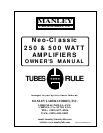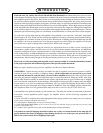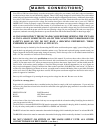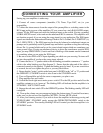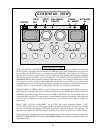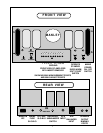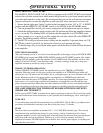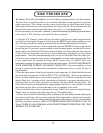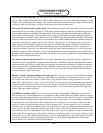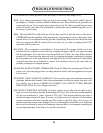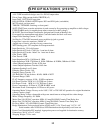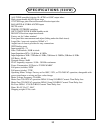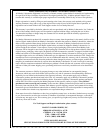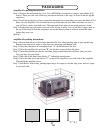
It is rare that any of these problems occur but if they do here are some things to try.
HUM - Try a mains ground adapter if they are legal in your country. They are also called 3 pin to 2
pin adapters or "cheaters" and are available in hardware stores. There should be one ground in your
system and only one. If two or more pieces of gear have 3 pin AC cables a ground loop can occur
which will usually cause hum. The preamplifier is probably the best grounded single piece as it is
the center of your system.
HISS - Throw the MUTE switch and listen. Did the hiss stop? If so, then the source of the hiss is
UPSTREAM from the amplifiers, being generated by your preamps or source components. Some
amount of hiss is to be expected from any gear that is amplifying. If the noise level stayed the same
when you engaged the MUTE switch, and it is too hissy for you, then try replacing the 12AT7
input tube with a quieter one.
BALANCE - The two speakers sound different - It may be the CD or source and the way it was
recorded. First try a different source. Next try swapping the inputs. MUTE your amps and swap
left and right inputs. If it is the source, then the problem will "follow" the swap. Return them to
normal (L=L). Power down the amps and next try swapping the speaker connections by putting
the left speaker wire in the right terminals and right wires into the left terminals. If the problem
switched sides then one monoblock is suspect; if the problem stayed on the same side it is
probably a damaged or fatigued speaker.
NO SOUND, NO PILOT LIGHT, TUBES DARK- Check AC Mains fuse on back panel. Check AC
power cord. Is the amp plugged into a working electrical outlet? (this has happened to everyone
at least once).
NO SOUND , PILOT LIGHT ON, TUBES LIT- Check speaker connection and input connection
(exchange with the other channel). Take a bias measurement- do all bias test points read zero volts?
If so, the B+ fuse is blown. CAREFULLY INSPECT ALL OUTPUT TUBES BEFORE
REPLACING FUSE. (See also "Replacing Tubes").
ONE OUTPUT TUBE WILL NOT BIAS- If the bias voltage one one tube will not adjust at all or
reads zero volts, first replace the tube. If the reading still is way off or reads zero, turn the amplifier
off. Set your multimeter to "ohms" instead of "DC volts". Now measure the bias test point- it
should read approximately 10 ohms. If it reads very high or not at all, then the 10 ohm cathode
resistor connected to the tube is burned open.This resistor is the final safety valve in case of a
shorted output tube, and prevents damage to the rest of the amplifier should this occur. Replacing
this resistor can be done by anyone with adequate soldering skills; we recommend contacting our
service department here at the factory for specific instructions.
11
TROUBLESHOOTING



